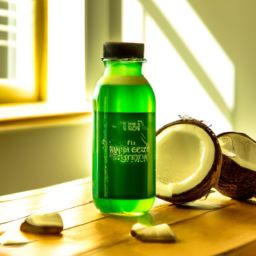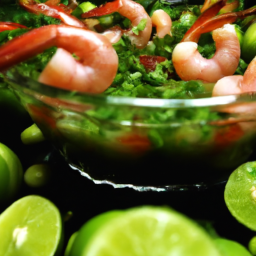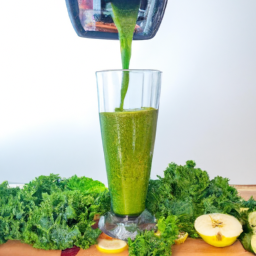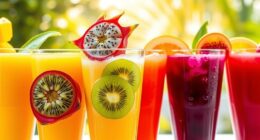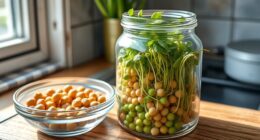Juicing has become increasingly popular as a way to boost your nutrient intake, detox your body, and improve your overall health. However, not everyone has a juicer, and buying one can be costly. As a result, I have decided to share some simple methods for juicing fruits without the need for a juicer.
In this article, I will guide you through different methods of juicing fruits using tools that you most likely already have in your kitchen. I will also provide tips on choosing the right fruits, preparing them, and adding flavor and nutrition boosters to your juice.
Juicing without a juicer can be just as easy and effective as using one, and I’m excited to show you how.
Key Takeaways
- Soft fruits can be blended or mashed, while hard fruits can be grated or blended after being cut into small pieces.
- Removing skins and seeds from hard fruits can prevent bitterness, and adding liquid to the blender can aid in the blending process.
- Using a fine-mesh strainer can effectively juice fruits, and experimenting with different fruit combinations can create delicious blends.
- Storing juice in an airtight container in the refrigerator can prolong its shelf life, and adding herbs and creative combinations can boost flavor and provide additional health benefits.
Why Juice Fruits Without a Juicer?
Why would you want to go through the hassle of using a juicer when you can easily juice fruits without one and still get all the health benefits? Juicing fruits without a juicer is a great alternative for those who don’t own a juicer or don’t want to invest in one.
Additionally, it’s a more natural and affordable option, as you can use simple household tools to get the job done.
The benefits of juicing fruits are numerous. It can help increase your daily intake of fruits and vegetables, which is important for maintaining a healthy diet.
Juicing also makes it easier for your body to absorb the nutrients in fruits, as it breaks down the cell walls and releases the nutrients into the juice.
Juicing can also help boost your immune system, improve digestion, and increase energy levels.
So, why not try juicing fruits without a juicer and reap all the benefits it has to offer?
Now, let’s talk about the tools you’ll need.
Tools You Will Need
To juice fruits without a juicer, you’ll need a few tools. A blender or food processor can be used to make smoothies or purees. These can then be strained through a fine-mesh strainer to remove any pulp.
For citrus fruits, a citrus reamer is a great tool to extract the juice and minimize pulp. These tools are essential for anyone looking to incorporate fresh juice into their diet without investing in a juicer.
Blender
Using a blender to juice fruits can be a piece of cake if you have a fine-mesh strainer to separate the pulp from the juice, like separating the wheat from the chaff. Here are some blender techniques that can help you achieve the perfect juice consistency:
- Start by cutting your fruits into small pieces to ensure they blend easily.
- Add a splash of water to the blender to help loosen the fruits and make blending easier.
- Blend on high speed for at least a minute or until all the fruits are pureed into a smoothie-like consistency.
Pour the mixture through a fine-mesh strainer into a bowl to separate the juice from the pulp.
Smoothie recipes that require blending fruits and vegetables can also benefit from these techniques. However, if you want a more pulp-free juice, consider using a food processor instead of a blender.
Food Processor
With a food processor, you can easily chop and blend fruits and vegetables to create delicious and nutritious juices. Although it may not extract the juice in the same way as a juicer does, a food processor can still provide many of the same juicing benefits.
For example, juicing with a food processor can help you consume more fruits and vegetables in a convenient and tasty way. It can also provide a quick and easy way to boost your nutrient intake and support your overall health.
When using a food processor for juicing, you can experiment with different fruits and vegetables and mix and match flavors to create your own unique blends. Some great options for juicing include leafy greens, such as kale and spinach, as well as fruits like apples, pears, and berries. You can also add herbs and spices to enhance the flavor and nutritional value of your juices.
While a food processor may not be the most traditional method for juicing, it can be a great alternative to juicers and provide a fun and creative way to incorporate more fruits and vegetables into your diet.
Speaking of alternatives to juicers, another option for juicing citrus fruits is a citrus reamer. With a citrus reamer, you can easily extract the juice from lemons, limes, oranges, and other citrus fruits.
Keep reading to learn more about how a citrus reamer can help you make fresh and flavorful citrus juices at home.
Citrus Reamer
You can enhance your citrus juices by incorporating a citrus reamer into your kitchen tools. Using a citrus reamer for juicing is a simple and efficient way to extract fresh and flavorful juice from lemons, limes, and oranges.
Unlike other juicing tools, such as a blender or food processor, a citrus reamer is specifically designed for juicing citrus fruits. It allows you to extract the maximum amount of juice from the fruit without any pulp or seeds, resulting in a smooth and delicious juice.
A citrus reamer is much easier to clean and maintain compared to other juicing tools. It is also more affordable and takes up less space in your kitchen. If you’re looking for a quick and easy way to make fresh citrus juices, a citrus reamer is a great tool to have.
However, if you want a smoother and more refined juice, you may want to consider using a fine-mesh strainer to remove any pulp or seeds that may have slipped through during the juicing process.
Fine-Mesh Strainer
If you want a smoother and more refined citrus beverage, a fine-mesh strainer can be a game-changer. It not only filters out any unwanted bits and pieces but also leaves behind only the purest and most refreshing liquid. Using a fine mesh strainer can make a big difference in the quality of your juice.
The strainer is especially useful when you are working with fruits that have a lot of pulp or seeds, such as oranges or grapefruits. By using the strainer, you can remove these unwanted parts and create a smooth, delicious beverage. However, using a fine mesh strainer does have its limitations.
Some fruits, such as berries or kiwis, have very small seeds that can slip through the holes in the strainer. In addition, the strainer may not be able to remove all of the pulp, which can result in a slightly thicker juice. Despite these limitations, a fine mesh strainer is still a great tool to have in your kitchen.
It can also be used for other tasks, such as straining pasta or rinsing vegetables. With a little creativity, you can find many alternative uses for a fine mesh strainer. When it comes to making fresh juice without a juicer, choosing the right fruits is essential.
Choosing the Right Fruits
When choosing fruits to juice without a juicer, it’s important to consider the type of fruit.
Citrus fruits, such as oranges and lemons, are great options because they have a high juice content and can be easily squeezed by hand.
Soft fruits, like berries and kiwi, can also be juiced without a juicer, but may require more effort to extract the juice.
Hard fruits, such as apples and pears, can be juiced by grating or blending them first.
By choosing the right fruits, you can ensure a successful juicing experience without the need for a juicer.
Citrus Fruits
Squeezing fresh citrus fruits by hand is the perfect way to add a burst of tangy flavor to your morning routine. Citrus fruits like oranges, lemons, and limes are rich in Vitamin C, folate, and potassium, making them a healthy addition to your diet.
When juicing citrus fruits, it’s important to choose fruits that are ripe and juicy. To get the most juice out of a citrus fruit, roll it on a hard surface to break down the membranes inside. Then, cut the fruit in half and use a citrus juicer or your hands to squeeze out the juice.
If you’re looking for a citrus juice recipe, try combining orange and grapefruit juice for a refreshing and healthy drink.
Moving on to soft fruits, these require a different juicing technique to extract the juice.
Soft Fruits
Oh, so you think juicing soft fruits is going to be a breeze? Well, think again! Juicing soft fruits can be a bit challenging, but not impossible. There are two main methods to juice soft fruits: blending and mashing. Blending involves using a blender to blend the soft fruits into a smoothie-like consistency. Mashing, on the other hand, requires you to manually mash the fruits using a potato masher or a fork.
Blending is a great way to juice soft fruits because it retains all the fiber and nutrients that are often lost in juicing. The downside to blending is that it can be time-consuming and may require additional ingredients to make the fruit more palatable. Mashing soft fruits is a quicker and simpler method, but it may not retain as many nutrients as blending. Regardless of the method you choose, using soft fruits in your juice can provide a multitude of benefits such as increased fiber and antioxidants. Now, let’s move on to hard fruits and how to juice them without a juicer.
| Blending | Mashing |
|---|---|
| Retains all fiber and nutrients | Quick and simple |
| Time-consuming | May not retain as many nutrients |
| May require additional ingredients | – |
Hard Fruits
In the previous subtopic, we discussed how to juice soft fruits without the use of a juicer. Now, let’s move on to juicing hard fruits. Hard fruits, such as apples, pears, and pineapples, require a different juicing technique compared to soft fruits.
When juicing hard fruits, it’s best to cut them into smaller pieces to make it easier for the blender to process. For example, cut apples into quarters and pineapples into chunks. This will also help prevent the blender from overheating.
It’s important to note that the skins and seeds of hard fruits can make the juice bitter, so it’s best to remove them before juicing. Additionally, hard fruits have a longer shelf life compared to soft fruits, so they can be stored in the refrigerator for a few days before juicing. This makes it easier to prepare the fruits in advance and ensures that they are fresh when it’s time to juice.
By using these juicing techniques and preserving your hard fruits, you can enjoy fresh, homemade juice anytime.
Moving forward, let’s talk about preparing your fruits for juicing.
Preparing Your Fruits
First, you’ll need to prepare your fruits before juicing them. This step is crucial in ensuring that you extract the maximum amount of juice from your fruits.
Start by washing your fruits thoroughly to remove any dirt or residue. This helps to eliminate any bacteria that might be present on the surface of the fruits. You can use a mixture of water and vinegar to wash your fruits, or you can use a fruit and vegetable wash that’s readily available in stores.
Once your fruits are clean, you can then proceed to slice them into smaller pieces. The size of the slices will depend on the juicing method that you’ll use. For example, if you plan to use a blender to juice your fruits, you can cut them into smaller pieces to make blending easier. However, if you plan to use a manual juicer, you’ll need to slice your fruits in a way that allows you to extract the maximum amount of juice.
With the preparation of your fruits complete, you can now move on to the next step of the juicing process, the blender method.
Blender Method
To start blending your fruit, you’ll wanna grab your favorite blender and toss in those deliciously sliced fruit pieces, blending them until they’re smooth as butter. But what if you don’t have a blender? Don’t worry, there are blender alternatives that you can use.
For example, you can use a hand-held immersion blender or a food mill. These tools work just as well as a regular blender and are perfect for juicing for beginners. When using a blender, it’s important to add a little bit of liquid to help the blending process. This could be water, coconut water, or any other liquid that you prefer.
Depending on the blender that you’re using, it may take a bit of effort to blend the fruit completely. But with a little bit of patience and persistence, you’ll be able to create a delicious and nutritious juice that’s perfect for any time of day.
Moving on to the next method, the food processor method, is a great way to juice fruits without a juicer.
Food Processor Method
If you’re looking for a way to whip up a healthy and refreshing drink without a fancy juicer, the food processor method is a great option. Unlike blending, where the fruits and vegetables are liquefied, the food processor method simply grinds the produce into tiny bits. This means that the resulting juice will be thicker and more pulpy, but still packed with nutrients.
One of the biggest pros of the food processor method is that it’s incredibly easy to do. All you need is a food processor, a fine mesh strainer, and your choice of fruits and vegetables. However, one of the cons is that you may need to strain the juice several times to remove any remaining pulp.
Overall, while the food processor method may not give you the same smooth consistency as a juicer, it’s a great alternative that allows you to still enjoy all the benefits of fresh juice.
Moving on to the next method, the citrus reamer method is another easy way to juice fruits without a juicer.
Citrus Reamer Method
Using a citrus reamer to extract the natural juices from your favorite citrus fruits is a simple and efficient method that allows you to savor the full flavor and nutritional benefits.
Here are some tips to help you get the most out of this juicing technique:
-
Fruit selection: Choose ripe citrus fruits that are heavy for their size and have a smooth, firm skin. Avoid fruits that are too soft or have blemishes, as they may not yield as much juice.
-
Juicing techniques: Cut the fruit in half crosswise and hold it over a bowl or measuring cup. Place the reamer in the center of the fruit and twist it back and forth while applying gentle pressure. Continue until all the juice has been extracted.
-
Cleanup: Rinse the reamer and any other utensils you used with warm water and soap. Dry them thoroughly before storing.
Using a citrus reamer is a great way to make fresh juice without a juicer. However, if you want a smoother consistency, you may want to strain the juice through a fine-mesh strainer. This will remove any pulp or seeds that may have been left behind during the juicing process.
Fine-Mesh Strainer Method
In my experience, using a fine-mesh strainer to juice fruits is a simple and effective method. To achieve the best results, it’s important to follow a step-by-step guide.
Start by selecting the right fruits and preparing them for juicing. Additionally, use a few tips such as pressing down on the pulp and stirring the juice to help maximize the amount of juice extracted.
Step-by-Step Guide
To get started on juicing fruits without a juicer, you’ll want to roll up your sleeves and get ready to put in some elbow grease. The fine-mesh strainer method is a great option for those who want to make creative juice blends without the need for a juicer. Here’s a step-by-step guide on how to juice fruits using this method:
-
Begin by selecting your choice of fruits and washing them thoroughly. Cut them into small pieces and remove any seeds or pits.
-
Place the fruit in a blender and add a small amount of water. Blend until the mixture becomes smooth.
-
Pour the fruit mixture into a fine-mesh strainer set over a bowl. Use a spatula or spoon to press the mixture against the strainer, extracting as much juice as possible.
-
Repeat the process until all the fruit has been juiced.
-
Transfer the juice to a glass and enjoy!
By using this juicing hack, you can create delicious and healthy juice blends without the need for a juicer. To ensure the best results, experiment with different fruit combinations and adjust the amount of water you add to the blender.
In the next section, we’ll share some tips on how to make the most out of this method.
Tips for Best Results
For the tastiest and healthiest blend, don’t forget to experiment with different combinations of your favorite produce. You’ll be amazed at how much flavor and nutrients you can pack into one glass! However, it’s important to pay attention to the juice consistency for the best results.
To achieve a smooth and consistent juice, make sure to alternate between softer and harder fruits and vegetables when feeding them into the blender. This will help prevent clogging and ensure even blending.
Storage tips are also important to keep in mind when juicing without a juicer. To prolong the shelf life of your juice, store it in an airtight container in the refrigerator for up to three days. It’s best to drink the juice as soon as possible for maximum freshness and nutrients, but if you need to store it, avoid leaving it out at room temperature for too long.
By following these simple tips, you can enjoy delicious and nutritious juice without a juicer.
When it comes to boosting the flavor and nutrition of your juice, there are many ingredients you can add to take it to the next level. Let’s explore some of these flavor and nutrition boosters in the next section.
Flavor and Nutrition Boosters
Adding a touch of honey or a squeeze of lemon can give your homemade fruit juice a little extra zing. But did you know that there are other ways to boost the flavor and nutrition of your juice?
For example, you can try adding herbs like mint or basil to your juice for a refreshing twist. Or, you can experiment with creative combinations like pineapple and ginger for a spicy kick. Not only do these flavor boosters make your juice taste better, they can also provide additional health benefits.
Mint, for instance, has been shown to aid digestion and reduce inflammation. Ginger, on the other hand, is known for its anti-inflammatory properties and ability to relieve nausea. So, next time you’re making juice at home, don’t be afraid to get creative with your flavor combinations and add some herbs or spices for an extra dose of nutrition.
Frequently Asked Questions
Can I use frozen fruits to make juice without a juicer?
Yes, frozen fruits can be used to make juice without a juicer. They are often more affordable and convenient than fresh fruits. To achieve the perfect texture, blend the fruits with a liquid and strain through a fine mesh sieve.
Is it necessary to remove the seeds and pits before juicing the fruits?
Removing seeds before juicing is crucial for some fruits, like apples and pears, as they contain trace amounts of cyanide. However, juicing with seeds can provide additional nutrients and fiber. Tips for removing seeds include using a knife or strainer.
How long can I store the freshly made juice without a juicer?
To prevent oxidation, I store freshly made juice in an airtight container in the refrigerator for up to 72 hours. I also add lemon juice to the juice to increase its shelf life. Proper storage tips are essential for preserving the nutrients and taste of the juice.
Can I use a regular strainer instead of a fine-mesh strainer for the juicing process?
Using a regular strainer instead of a fine-mesh strainer for juicing may not be as effective in removing pulp and seeds. Strainer alternatives include cheesecloth or a nut milk bag. Juicing tips: choose ripe fruits, wash thoroughly, and use a blender or food processor.
Are there any fruits that should not be used for juicing without a juicer?
Some fruits are not ideal for juicing without a juicer, such as bananas and avocados. The best alternative juicing methods include using a blender or squeezing by hand. Always wash fruits thoroughly before juicing.
Conclusion
In conclusion, juicing fruits without a juicer is an easy and accessible way to enjoy fresh and healthy juices at home. With just a few tools and some basic preparation, you can create delicious and nutritious drinks that will boost your energy and support your overall well-being.
Whether you choose to use a blender, a food processor, a citrus reamer, or a fine-mesh strainer, make sure to select the right fruits, clean them thoroughly, and add some flavor and nutrition boosters for extra benefits.
As Hippocrates famously said, "Let food be thy medicine and medicine be thy food."By incorporating more fruits and vegetables into our diets, we can prevent and treat many health issues, such as inflammation, oxidative stress, and metabolic disorders. Juicing is a convenient way to consume a variety of fruits in one serving, while also preserving their nutrients and enzymes.
So, next time you crave a refreshing drink, try juicing some fruits without a juicer and enjoy the benefits of nature’s medicine.
Ilana has been a vegan for over 10 years. She originally made the switch for health reasons, but soon found herself becoming more and more passionate about the ethical and environmental implications of a vegan lifestyle. Ilana is the author of The Graceful Kitchen, a blog all about veganism. She loves to cook up delicious and nutritious vegan meals, and share her recipes with others who are interested in leading a cruelty-free life. Ilana is also a strong advocate for using whole foods as the foundation of a healthy diet, and believes that going vegan is one of the best ways to achieve this.



